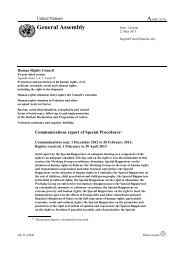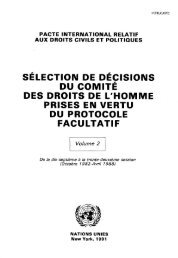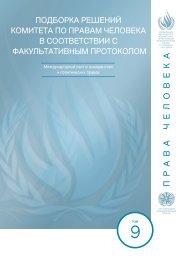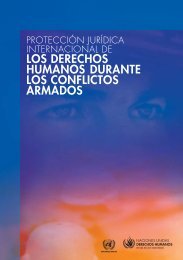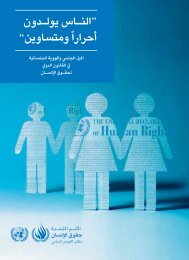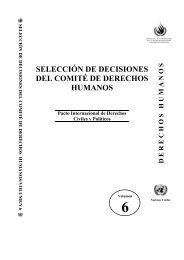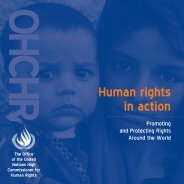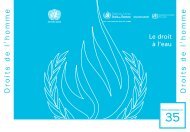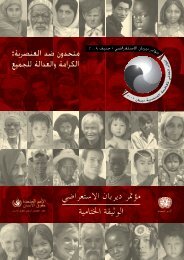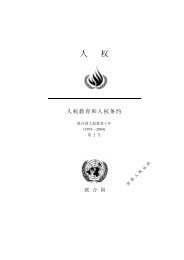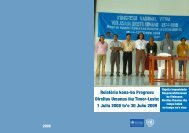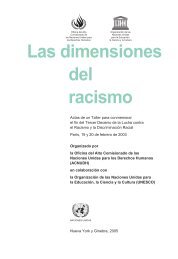good governance practices for the protection of human rights
good governance practices for the protection of human rights
good governance practices for the protection of human rights
You also want an ePaper? Increase the reach of your titles
YUMPU automatically turns print PDFs into web optimized ePapers that Google loves.
poverty and inequality and guaranteeing <strong>human</strong> <strong>rights</strong>. There is room <strong>for</strong><br />
continued improvement in <strong>the</strong> amount and quality <strong>of</strong> social expenditure, which<br />
a more transparent budgeting system is helping to achieve.<br />
D. Improving access to health services through intercultural<br />
mediation – Romania<br />
Issue<br />
About 2.5 million Roma live in Romania, where <strong>the</strong>y make up 11 per cent <strong>of</strong><br />
<strong>the</strong> population. The Roma have significantly worse health indicators, including<br />
higher rates <strong>of</strong> infant mortality and communicable diseases and shorter life expectancy,<br />
than <strong>the</strong> rest <strong>of</strong> <strong>the</strong> Romanian population. Unhealthy living conditions<br />
are one <strong>of</strong> <strong>the</strong> major causes <strong>of</strong> poorer health among <strong>the</strong> Roma, particularly those<br />
living in <strong>the</strong> many ghettoized settlements. However, <strong>the</strong> discrepancies between<br />
<strong>the</strong> health indicators <strong>of</strong> <strong>the</strong> Roma and <strong>the</strong> majority community also result from<br />
structural inequalities, including unequal access to education and employment,<br />
discrimination and poverty.<br />
The social and economic conditions in which <strong>the</strong> Roma live undermine <strong>the</strong>ir<br />
right to <strong>the</strong> enjoyment <strong>of</strong> health and <strong>the</strong>ir right to equitable and non-discriminatory<br />
access to public health and medical services.<br />
Response<br />
The Roma health mediator (RHM) programme, launched in 1997, recognized<br />
that social and cultural conditions played a key role in determining <strong>the</strong> availability,<br />
accessibility and quality <strong>of</strong> health services. A founding concept <strong>of</strong> <strong>the</strong> programme<br />
is that cultural and linguistic barriers <strong>of</strong>ten prevent communities from<br />
accessing public health services. The RHM programme attempts, through intercultural<br />
mediation, to facilitate <strong>the</strong> communication between <strong>the</strong> minority population<br />
and <strong>the</strong> public authorities on health issues. It also seeks to empower<br />
<strong>the</strong> Roma population to access <strong>the</strong> health system by providing in<strong>for</strong>mation and<br />
raising awareness both about <strong>the</strong> public health system and about health issues.<br />
Design<br />
In Romania, health mediation was initiated by <strong>the</strong> Roma Center <strong>for</strong> Social Intervention<br />
and Studies (Romani CRISS). Following a 1997 report by Doctors Without<br />
Borders that Roma in Romania were refusing vaccination, Romani CRISS<br />
discovered that doctors <strong>of</strong>ten refused to enter Roma communities, while Roma<br />
feared <strong>the</strong> effects <strong>of</strong> vaccination and failed to understand its importance.<br />
In response, Romani CRISS trained Roma health mediators to serve as a bridge<br />
between <strong>the</strong> Roma community and <strong>the</strong> public health system. The RHM programme<br />
aimed to improve community health by: mediating between Roma<br />
patients and doctors during medical consultations; communicating with Roma<br />
38



